Citroen C4 CACTUS RHD 2014 1.G User Guide
Manufacturer: CITROEN, Model Year: 2014, Model line: C4 CACTUS RHD, Model: Citroen C4 CACTUS RHD 2014 1.GPages: 331, PDF Size: 8.56 MB
Page 11 of 331

9
7-inch touch screen tablet
Operation
Use the buttons arranged either side of the
touch screen tablet for access to the menus,
then press on the virtual buttons in the screen.
Each menu is displayed over one or two pages
(primary page and secondary page).For access to the secondary page
(from the primary page).
To return to the primary page
(from the secondary page).
For access to additional information
and to the settings for certain
functions.
To confirm.
To quit.
Menus
37 "
Air conditioning ".
Do not use pointed objects on the touch
screen.
Do not touch the touch screen with wet
hands. Use a clean soft cloth to clean the touch
screen tablet.
"
Driving assistance ".
" Media ".
" Navigation ". "
Configuration ".
" Connected services ".
" Telephone ".
.
Familiarisation
Page 12 of 331
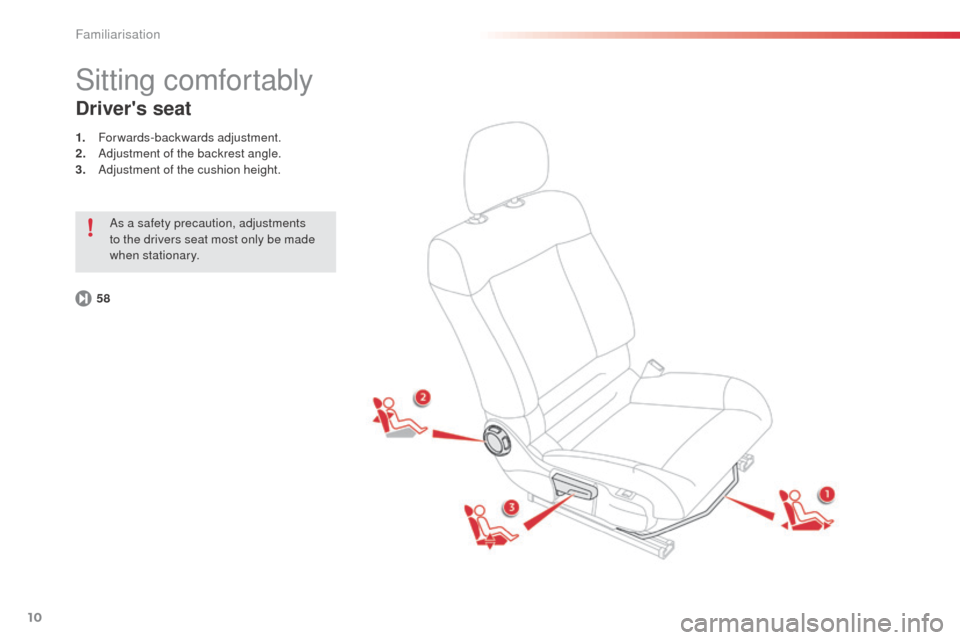
10
Sitting comfortably
Driver's seat
1. Forwards-backwards adjustment.
2. Adjustment of the backrest angle.
3.
A
djustment of the cushion height.
58 As a safety precaution, adjustments
to the drivers seat most only be made
when stationary.
Familiarisation
Page 13 of 331
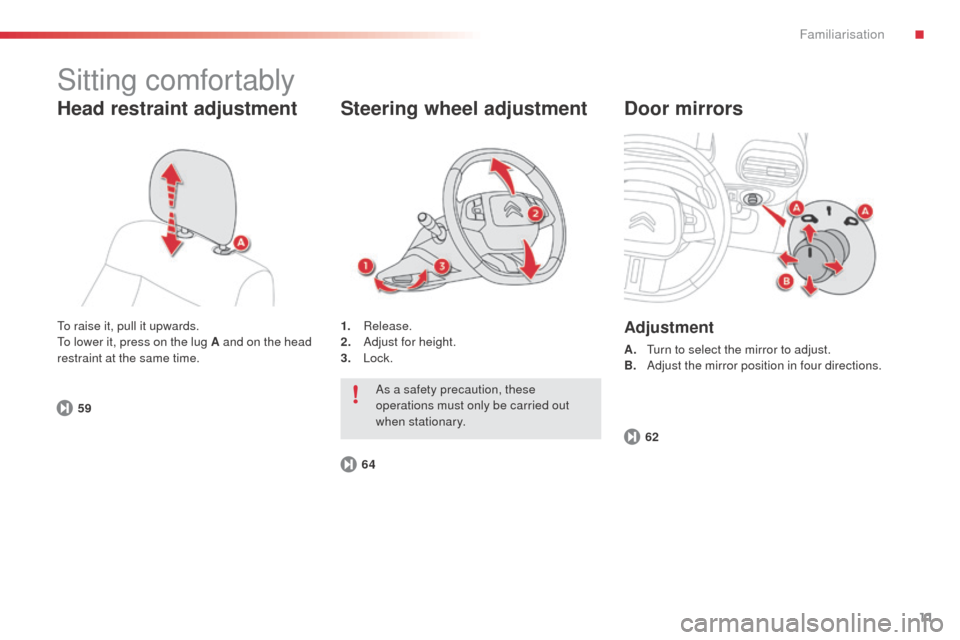
11
Sitting comfortably
Head restraint adjustment
To raise it, pull it upwards.
To lower it, press on the lug A and on the head
restraint at the same time.62
59 1.
Release.
2. A djust for height.
3.
Lock.
Steering wheel adjustment
64
Door mirrors
Adjustment
A. Turn to select the mirror to adjust.
B. Adjust the mirror position in four directions.
As a safety precaution, these
operations must only be carried out
when stationary.
.
Familiarisation
Page 14 of 331
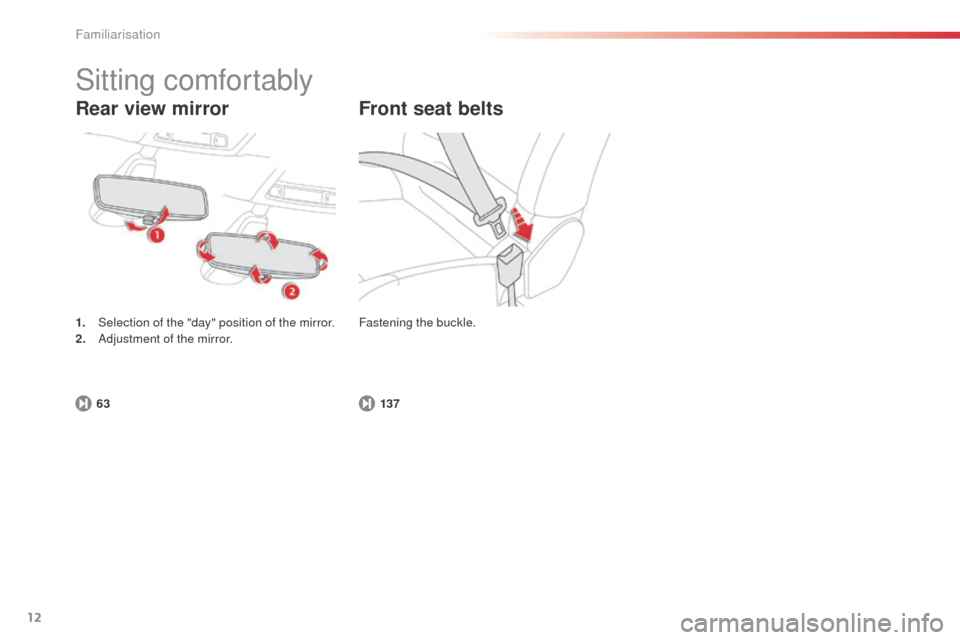
12
Sitting comfortably
Rear view mirror
1. Selection of the "day" position of the mirror.
2. Adjustment of the mirror.
63 Fastening the buckle.
Front seat belts
137
Familiarisation
Page 15 of 331

13
Seeing clearly
Lighting
Ring A
Ring B
Lighting off/daytime running lamps.
Automatic illumination of headlamps.
Sidelamps.
Dipped / main beam headlamps.123
114
115
Rear foglamp only.
Wipers
Stalk A: windscreen wipers
2. Fast wipe.
1. N ormal wipe.
Int.
I
ntermittent wipe.
0.
Of f.
â
S
ingle wipe: pull the stalk briefly towards
you.
or
AUTO
A
utomatic wiping.
122
Switching on "AUTO"
F Press the stalk downwards.
Switching off "AUTO"
F Press the stalk downwards again or place the stalk in another position (Int, 1 or 2).
124
Ring B: rear wiper
Park.
Intermittent wipe.
Wipe with screen wash.
Front foglamps and rear foglamp.
.
Familiarisation
Page 16 of 331
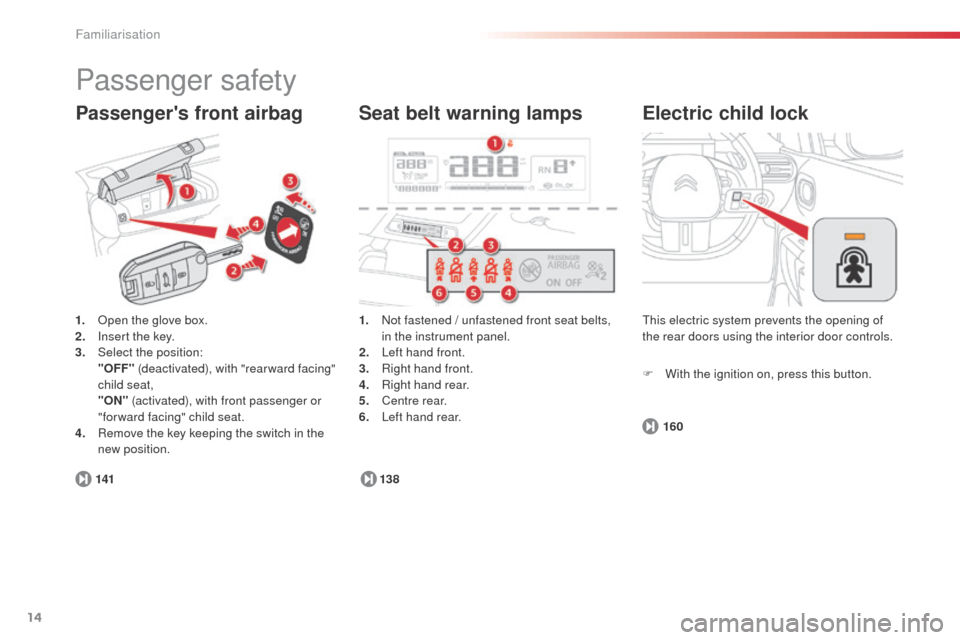
14
Passenger's front airbag
Passenger safety
160
141 1.
N
ot fastened / unfastened front seat belts,
in the instrument panel.
2.
L
eft hand front.
3.
R
ight hand front.
4.
R
ight hand rear.
5.
C
entre rear.
6. L
eft hand rear.
138
Seat belt warning lamps
This electric system prevents the opening of
the rear doors using the interior door controls.
Electric child lock
1. Open the glove box.
2. I nsert the key.
3.
Sel
ect the position:
"
OFF" (deactivated), with "rear ward facing"
child seat,
"ON" (activated), with front passenger or
"for ward facing" child seat.
4.
R
emove the key keeping the switch in the
new position. F
W
ith the ignition on, press this button.
Familiarisation
Page 17 of 331
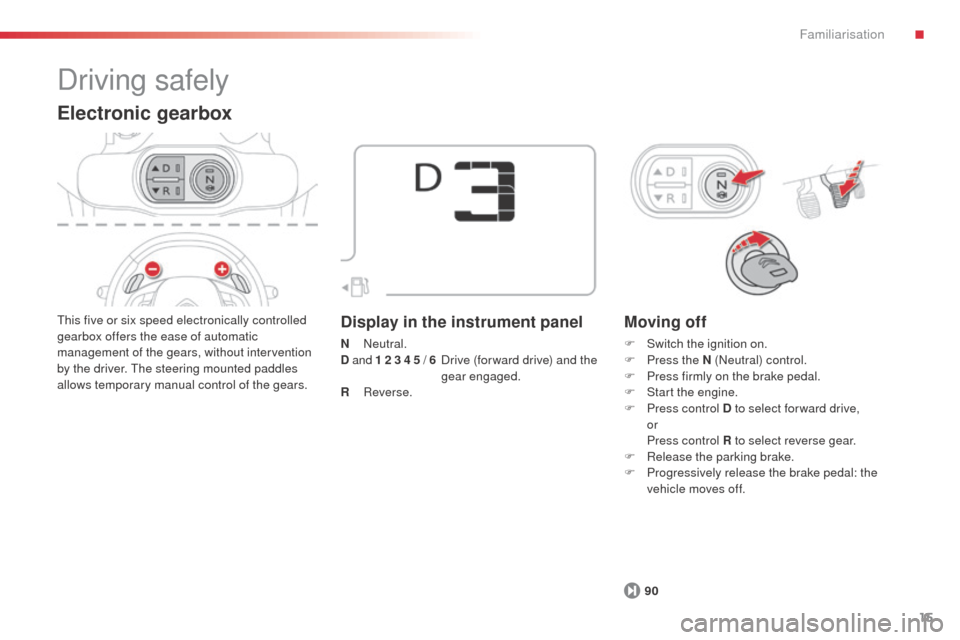
15
Driving safely
Electronic gearbox
This five or six speed electronically controlled
gearbox offers the ease of automatic
management of the gears, without intervention
by the driver. The steering mounted paddles
allows temporary manual control of the gears.Display in the instrument panel
N Neutral.
D a
nd 1 2 3 4 5 / 6 D rive (for ward drive) and the
gear engaged.
R
Reverse.
Moving off
F Switch the ignition on.
F P ress the N (Neutral) control.
F
P
ress firmly on the brake pedal.
F
S
tart the engine.
F
P
ress control D to select for ward drive,
or
P
ress control R to select reverse gear.
F
R
elease the parking brake.
F
P
rogressively release the brake pedal: the
vehicle moves off.
90
.
Familiarisation
Page 18 of 331
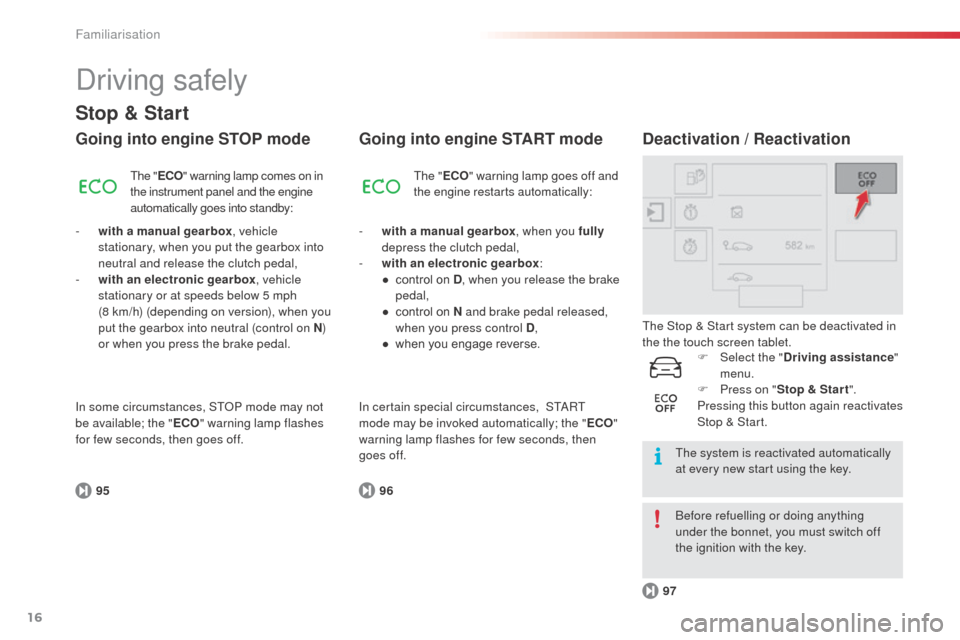
16
Stop & Start
Going into engine STOP mode
95The "
ECO" warning lamp comes on in
the instrument panel and the engine
automatically goes into standby:
Going into engine START mode Deactivation / Reactivation
96
97
The "
ECO" warning lamp goes off and
the engine restarts automatically:
-
w
ith a manual gearbox
, when you fully
depress the clutch pedal,
-
w
ith an electronic gearbox
:
●
c
ontrol on
D, when you release the brake
pedal,
●
c
ontrol on N and brake pedal released,
when you press control D ,
●
w
hen you engage reverse.
-
w
ith a manual gearbox
, vehicle
stationary, when you put the gearbox into
neutral and release the clutch pedal,
-
w
ith an electronic gearbox
, vehicle
stationary or at speeds below 5 mph
(8
km/h) (depending on version), when you
put the gearbox into neutral (control on N )
or when you press the brake pedal.
In certain special circumstances, START
mode may be invoked automatically; the " ECO"
warning lamp flashes for few seconds, then
goes off.
In some circumstances, STOP mode may not
be available; the "
ECO" warning lamp flashes
for few seconds, then goes off.
Driving safely
F Select the " Driving assistance "
menu.
F
P
ress on " Stop & Star t ".
Pressing this button again reactivates
Stop & Start.
Before refuelling or doing anything
under the bonnet, you must switch off
the ignition with the key. The system is reactivated automatically
at every new start using the key.
The Stop & Start system can be deactivated in
the the touch screen tablet.
Familiarisation
Page 19 of 331
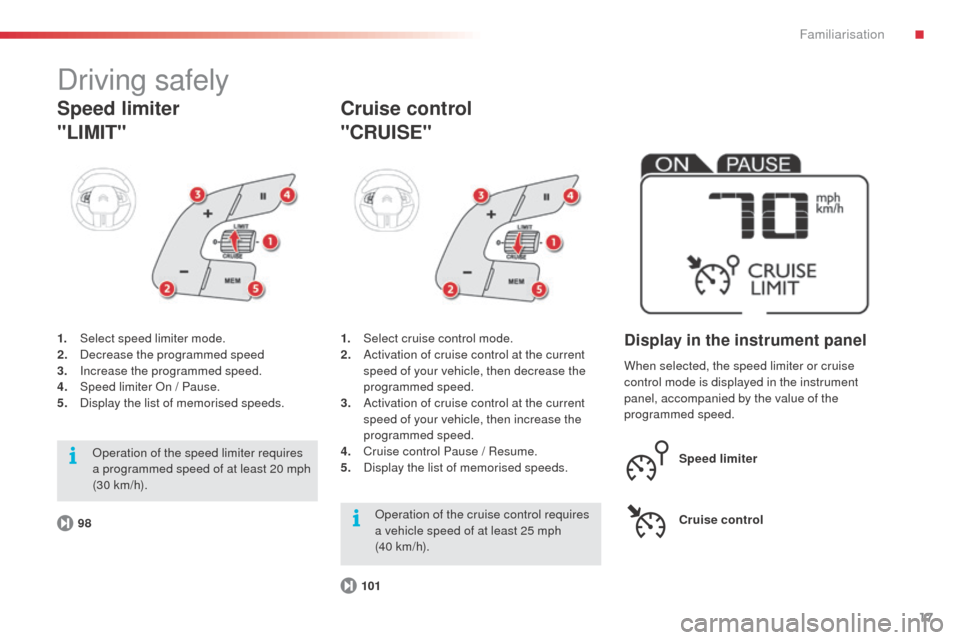
17
Driving safely
1. Select speed limiter mode.
2. Decrease the programmed speed
3.
In
crease the programmed speed.
4.
S
peed limiter On / Pause.
5.
D
isplay the list of memorised speeds.
Speed limiter
"LIMIT"
98 1.
Sel
ect cruise control mode.
2.
A
ctivation of cruise control at the current
speed of your vehicle, then decrease the
programmed speed.
3.
A
ctivation of cruise control at the current
speed of your vehicle, then increase the
programmed speed.
4.
C
ruise control Pause / Resume.
5.
D
isplay the list of memorised speeds.
Cruise control
"CRUISE"
101When selected, the speed limiter or cruise
control mode is displayed in the instrument
panel, accompanied by the value of the
programmed speed.
Display in the instrument panel
Speed limiter
Cruise control
Operation of the speed limiter requires
a programmed speed of at least 20 mph
(30 km/h).
Operation of the cruise control requires
a vehicle speed of at least 25 mph
(40 km/h).
.
Familiarisation
Page 20 of 331
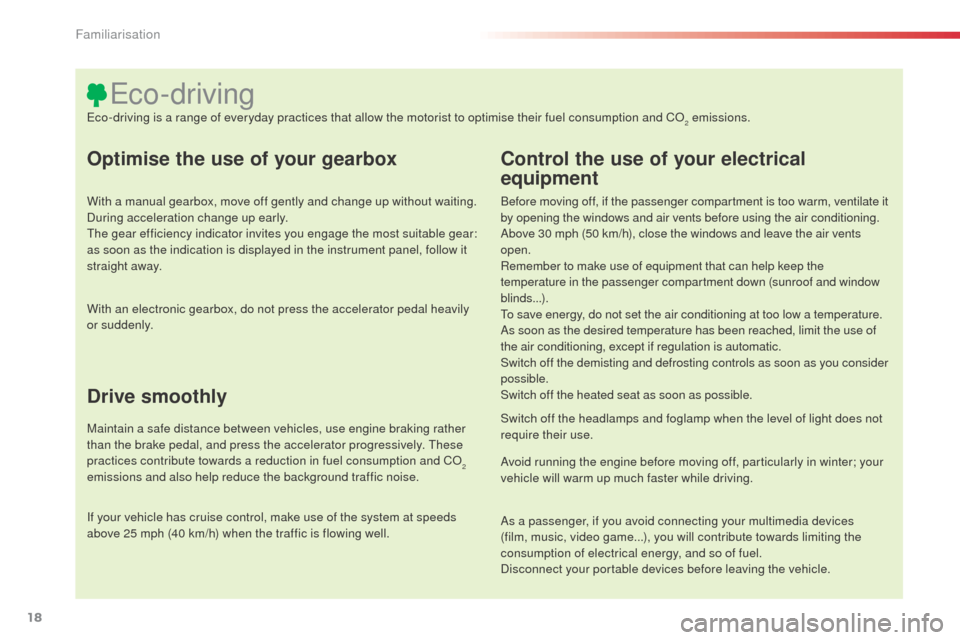
18
Optimise the use of your gearbox
With a manual gearbox, move off gently and change up without waiting.
During acceleration change up early.
The gear efficiency indicator invites you engage the most suitable gear:
as soon as the indication is displayed in the instrument panel, follow it
straight away.
Control the use of your electrical
equipment
Before moving off, if the passenger compartment is too warm, ventilate it
by opening the windows and air vents before using the air conditioning.
Above 30 mph (50 km/h), close the windows and leave the air vents
open.
Remember to make use of equipment that can help keep the
temperature in the passenger compartment down (sunroof and window
blinds...).
To save energy, do not set the air conditioning at too low a temperature.
As soon as the desired temperature has been reached, limit the use of
the air conditioning, except if regulation is automatic.
Switch off the demisting and defrosting controls as soon as you consider
possible.
Switch off the heated seat as soon as possible.
Switch off the headlamps and foglamp when the level of light does not
require their use.
Avoid running the engine before moving off, particularly in winter; your
vehicle will warm up much faster while driving.
As a passenger, if you avoid connecting your multimedia devices
(film, music, video game...), you will contribute towards limiting the
consumption of electrical energy, and so of fuel.
Disconnect your portable devices before leaving the vehicle.
Eco-driving
Eco-driving is a range of everyday practices that allow the motorist to optimise their fuel consumption and CO2 emissions.
With an electronic gearbox, do not press the accelerator pedal heavily
or suddenly.
Drive smoothly
Maintain a safe distance between vehicles, use engine braking rather
than the brake pedal, and press the accelerator progressively. These
practices contribute towards a reduction in fuel consumption and CO
2
emissions and also help reduce the background traffic noise.
If your vehicle has cruise control, make use of the system at speeds
above 25 mph (40 km/h) when the traffic is flowing well.
Familiarisation